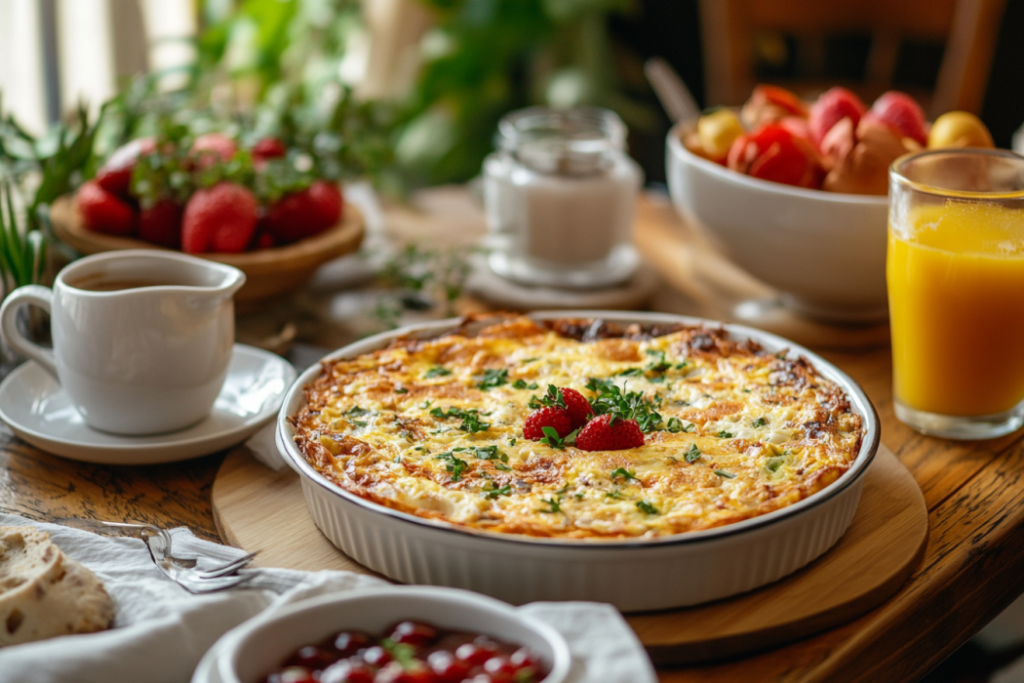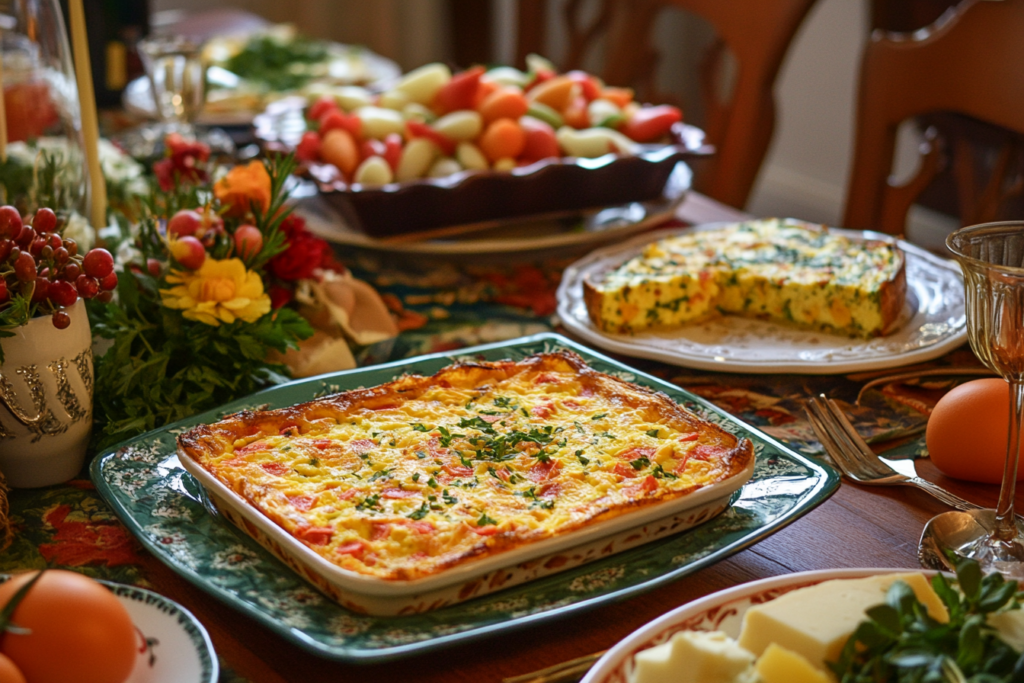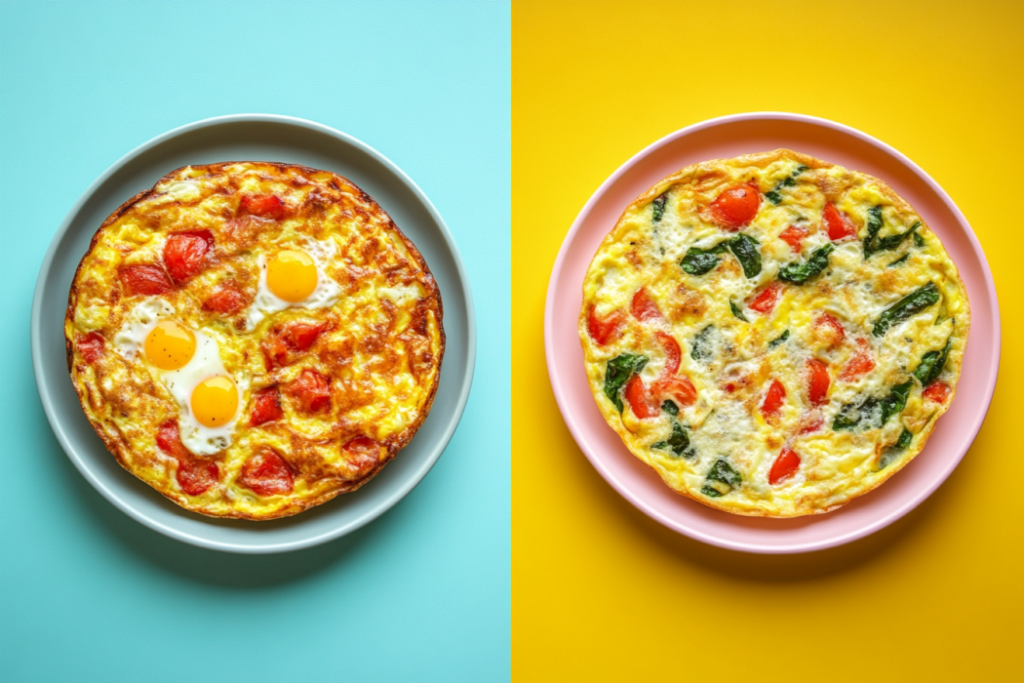
Eggs are one of the most versatile foods out there. You can fry them, boil them, scramble them, or bake them. But when it comes to egg-based dishes like egg bake and frittata, things can get a little confusing. Both are packed with flavor, filled with yummy ingredients, and make a great meal for breakfast, lunch, or dinner. So, what’s the difference between the two?
This article will break down everything you need to know about egg bake and frittata, from how they’re made to when to serve them. By the end, you’ll be a pro at telling them apart and maybe even inspired to cook one yourself. Let’s dive in!
What is an Egg Bake?
Definition and Description
An egg bake, also known as an egg casserole, is a hearty dish made by combining beaten eggs with a variety of ingredients, then baking the mixture in the oven. It’s a go-to choice for family breakfasts, brunches, or even potluck dinners. The texture of an egg bake is firm and somewhat fluffy, making it feel like a satisfying meal in every bite.
Unlike many egg dishes, egg bakes are made to serve multiple people at once, making them ideal for big gatherings. They’re often prepared in a large rectangular dish and served in slices.
Key Ingredients in an Egg Bake
Egg bakes are incredibly flexible when it comes to ingredients, but here are some common components:
- Eggs: The main star of the dish, providing structure and protein.
- Dairy: Milk, cream, or even yogurt to add creaminess and richness.
- Vegetables: Bell peppers, spinach, onions, or mushrooms are popular choices.
- Meats: Sausage for a savory punch.
- Cheese: Cheddar, mozzarella, or feta to bring it all together with a cheesy goodness.
- Spices and Herbs: Salt, pepper, paprika, and parsley for added flavor.
How Egg Bakes Are Prepared
Making an egg bake is simple and doesn’t require fancy cooking skills:
- Preheat the Oven: Typically set to around 350°F (175°C).
- Prepare Ingredients: Chop your vegetables, cook your meats, and shred your cheese.
- Mix the Egg Mixture: In a bowl, whisk together eggs, dairy, and seasonings.
- Assemble the Bake: Layer the meats, veggies, and cheese in a greased baking dish. Pour the egg mixture over the top.
- Bake: Place the dish in the oven and cook until the eggs are set and the top is slightly golden, usually 30–40 minutes.
An egg bake can be prepped the night before and baked fresh in the morning, making it a favorite for busy schedules.

What is a Frittata?
Definition and Description
A frittata is an Italian-style egg dish that’s often described as a cross between an omelet and a crustless quiche. It’s made by whisking eggs with a variety of ingredients and cooking the mixture on the stovetop before finishing it in the oven or under a broiler.
The word “frittata” comes from the Italian verb friggere, meaning “to fry,” which hints at its stovetop origins. Frittatas are known for their tender, custard-like texture and are typically served sliced, much like a pie or pizza.
Key Ingredients in a Frittata
While frittatas can be customized to suit your taste, here are the staples:
- Eggs: The foundation of the dish.
- Dairy: Cream, milk, or even ricotta cheese for a rich, creamy consistency.
- Vegetables: Zucchini, tomatoes, spinach, and peppers are common choices.
- Meats: Often includes prosciutto, or sausage for extra flavor.
- Cheese: Parmesan, goat cheese, or cheddar for a cheesy touch.
- Herbs: Basil, thyme, or parsley to add freshness.
- Seasonings: Salt, pepper, and occasionally a pinch of nutmeg.
How Frittatas Are Made
The process of making a frittata is quick and straightforward, requiring just a skillet and some basic kitchen tools:
- Whisk the Eggs: Combine eggs, dairy, and seasonings in a bowl until smooth.
- Cook the Fillings: In a skillet, sauté vegetables, meats, and any other add-ins with a little oil or butter until tender.
- Add the Egg Mixture: Pour the whisked eggs over the cooked fillings, stirring gently to combine.
- Cook on the Stovetop: Let the mixture cook on low heat until the edges are set, but the center remains slightly runny.
- Finish in the Oven or Broiler: Transfer the skillet to the oven or broiler to cook the top until it’s golden and fully set.
Unlike an egg bake, which is baked entirely in the oven, a frittata is mostly cooked on the stovetop, giving it a slightly different texture and appearance.
Egg Bake vs. Frittata: Key Differences
Now that we know what egg bakes and frittatas are, let’s explore how they differ. While both dishes use eggs as the main ingredient, their preparation methods, textures, and serving styles set them apart.
Texture and Consistency
The most noticeable difference between an egg bake and a frittata is their texture.
- Egg Bake: The texture of an egg bake is denser and more uniform, as it is cooked entirely in the oven. It’s often fluffy due to the addition of milk or cream and rises slightly as it bakes.
- Frittata: Frittatas have a more delicate, custard-like texture because they are cooked partially on the stovetop. The combination of stovetop and oven cooking helps create a creamy interior with slightly crispy edges.
Cooking Techniques
How these dishes are cooked plays a major role in their differences:
- Egg Bake: Always baked in the oven. The process is straightforward—just combine all the ingredients and let the oven do the work.
- Frittata: Begins on the stovetop. The eggs and fillings are cooked together in a skillet, then transferred to the oven or broiler to finish. This method requires a bit more attention to prevent burning on the stovetop.
Portion Sizes and Uses
Egg bakes and frittatas are both versatile, but their serving styles vary:
- Egg Bake: Typically made in a large casserole dish, an egg bake is designed for serving multiple people at once. It’s ideal for gatherings like family brunches or holiday breakfasts.
- Frittata: Usually prepared in a skillet and served in pie-like slices, frittatas are perfect for smaller groups or even as a single-serving meal when made in smaller pans.

Similarities Between Egg Bake and Frittata
While egg bakes and frittatas have their differences, they share plenty in common, which is why people sometimes confuse the two. Let’s take a closer look at their similarities.
Shared Ingredients
Both dishes are built around a simple yet versatile set of ingredients:
- Eggs: The foundation of both dishes, providing protein and structure.
- Dairy: Milk or cream is used in both recipes to enhance texture and flavor.
- Vegetables: Both dishes can include vegetables like onions, spinach, peppers, and mushrooms for added nutrition and taste.
- Cheese: A key ingredient in both, cheese adds creaminess and richness to each bite.
- Meats: Sausage, or even shredded chicken can be used in either dish to make them heartier.
Nutritional Value
Egg bakes and frittatas are both nutritious options for meals.
- Protein-Packed: Thanks to the eggs and optional meat, both dishes are high in protein, which helps keep you full and energized.
- Customizable Nutrition: You can make either dish healthier by adding more vegetables, using low-fat dairy, or skipping the meat altogether for a vegetarian option.
Versatility
One of the best things about both egg bakes and frittatas is how adaptable they are:
- Any Meal: While they’re often thought of as breakfast or brunch dishes, both can easily double as lunch or dinner options.
- Customizable Add-Ins: Both dishes allow you to get creative with ingredients, whether you’re using leftovers or experimenting with new combinations.
- Diet-Friendly: They can be tailored to fit a variety of diets, including keto, vegetarian, or gluten-free.
When Should You Make an Egg Bake?
Egg bakes are ideal for specific situations where their ease of preparation and ability to feed a crowd shine. Let’s explore the best occasions to whip up this tasty dish.
Perfect for Gatherings
Egg bakes are the ultimate crowd-pleaser for larger gatherings. They’re often prepared in a casserole dish, making it easy to serve multiple people at once. Here are some examples:
- Family Breakfasts: A comforting choice for a weekend breakfast when the whole family gathers around the table.
- Holiday Brunches: Popular during holidays like Christmas or Easter, as they can be prepped ahead of time.
- Potlucks and Office Parties: Their versatility allows you to include ingredients that appeal to everyone.
Great for Meal Prep
An egg bake is an excellent option for meal prepping. You can make a large batch and refrigerate individual portions to enjoy throughout the week. This makes it a go-to choice for busy students, parents, or professionals who want something quick and nutritious.
Easy to Customize for Dietary Needs
Since egg bakes are so flexible, you can easily adjust the recipe to suit dietary preferences or restrictions. For instance:
- Vegetarian Option: Skip the meat and add more vegetables like zucchini or bell peppers.
- Low-Carb Option: Skip the bread or hash browns and focus on eggs, meat, and cheese.
- Gluten-Free Option: Stick to naturally gluten-free ingredients like eggs, vegetables, and meats.
Best for Feeding Hungry Crowds
If you’re feeding a large group of people, egg bakes are hard to beat. Their hearty texture and mix of ingredients make them satisfying and filling. Plus, you can prepare them ahead of time, freeing you up to enjoy time with your guests.
When Should You Make a Frittata?
A frittata is the perfect dish for moments when you want something quick, versatile, and just a little fancy. Here are the best times to make one.
Ideal for Quick Meals
Frittatas are fast and easy to prepare, making them a go-to option for busy days:
- Weeknight Dinners: When you’re short on time but want a homemade meal, a frittata can be ready in under 30 minutes.
- Weekend Brunches: A frittata is perfect for a cozy, laid-back brunch with family or friends.
- Last-Minute Guests: With just a few simple ingredients, you can quickly whip up a frittata that looks and tastes impressive.
Perfect for Using Leftovers
Have a fridge full of random leftovers? A frittata can turn those odds and ends into a delicious meal. Some examples include:
- Leftover Vegetables: Roasted or sautéed veggies can easily be folded into a frittata.
- Cooked Meats: Shredded chicken or even crumbled sausage make excellent additions.
- Cheese Scraps: Bits of cheese from other meals can be grated and sprinkled into the mix.
Great for Smaller Gatherings
Frittatas are usually cooked in a skillet, making them ideal for serving smaller groups. For example:
- Intimate Breakfasts: A frittata serves just the right number of people for a small breakfast or brunch.
- Casual Lunches: Pair it with a simple salad or a slice of bread for a light but satisfying lunch.
Best for a Sophisticated Touch
Thanks to their Italian roots and pie-like presentation, frittatas feel a little more refined than other egg dishes. This makes them a great choice for occasions where you want something special without too much effort. For instance:
- Dinner Parties: Serve a slice of frittata alongside roasted vegetables or a grain salad.
- Picnics or Potlucks: A frittata is portable and tastes just as good at room temperature as it does fresh from the skillet.
FAQs
What is the main difference between an egg bake and a frittata?
The main difference lies in how they’re cooked. An egg bake is prepared entirely in the oven, typically in a casserole dish, making it perfect for feeding larger groups. In contrast, a frittata starts on the stovetop in a skillet and finishes in the oven or under a broiler, making it a lighter dish ideal for smaller gatherings. For a unique take on egg bakes, check out this Cottage Cheese Egg Bake: Healthy Protein-Packed Recipe.
Can I turn a frittata into an egg bake or vice versa?
Yes, with a few adjustments! To turn a frittata into an egg bake, mix the ingredients as you would for a frittata and bake them in a casserole dish instead of a skillet. To make an egg bake more like a frittata, prepare the ingredients in a stovetop skillet and finish cooking it under a broiler. For tips on boosting flavor and nutrition, learn Why Put Cottage Cheese in Eggs?.
Which dish is healthier: egg bake or frittata?
Both dishes can be equally healthy depending on the ingredients you use. If you add lots of vegetables and use minimal cheese or cream, both are nutritious and low-carb options packed with protein. However, egg bakes can sometimes include higher-calorie ingredients like bread or hash browns, while frittatas are typically lighter. For a healthier egg bake variation, consider this Cottage Cheese Egg Bake: Healthy Protein-Packed Recipe.
How long do egg bakes and frittatas last in the fridge?
Both dishes can be stored in an airtight container in the refrigerator for 3–4 days. To reheat, warm them in the oven or microwave until heated through.
Can you freeze an egg bake or a frittata?
Yes! Both egg bakes and frittatas freeze well. To freeze, let the dish cool completely, then wrap it tightly in plastic wrap and foil or place it in an airtight container. Freeze for up to 2–3 months. To reheat, thaw overnight in the fridge and warm in the oven.
Do you need to flip a frittata?
No, flipping a frittata isn’t necessary. Cooking it on the stovetop and finishing it in the oven ensures the eggs set evenly without needing to flip.
Conclusion
Egg bake and frittata are both delicious, versatile egg dishes that can be customized to fit any occasion. While they share similarities in ingredients and adaptability, their differences make them unique. An egg bake is perfect for feeding a crowd at a brunch or potluck, offering a hearty, casserole-style meal. On the other hand, a frittata is quick, elegant, and ideal for smaller groups or last-minute meals.
Whether you’re planning a family gathering, meal prepping for the week, or looking for a way to use up leftovers, both dishes are fantastic options. Why not try making both and see which one becomes your favorite? Happy cooking!
